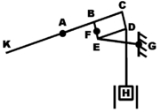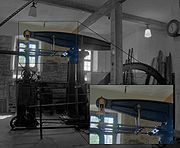
Parallel motion
Encyclopedia
The parallel motion is a mechanical linkage
invented by the Scottish
engineer
James Watt
in 1784 for his double-acting steam engine
.
In previous engines built by Newcomen
and Watt, the piston
pulled one end of the walking beam downwards during the power stroke using a chain, and the weight of the pump pulled the other end of the beam downwards during the recovery stroke using a second chain, the alternating forces producing the rocking motion of the beam. In Watt's new double-acting engine, the piston produced power on both the upward and downward strokes, so a chain could not be used to transmit the force to the beam. Watt designed the parallel motion to transmit force in both directions whilst keeping the piston rod vertical. He called it "parallel motion" because both the piston and the pump rod were required to move vertically, parallel to one another.
In a letter to his son in 1808, James Watt wrote "I am more proud of the parallel motion than of any other invention I have ever made."


 See the diagram on the right. A is the journal (bearing) of the walking beam KAC, which rocks up and down about A. H is the piston, which is required to move vertically but not horizontally. The heart of the design is the four-bar linkage consisting of AB, BE and EG and the base link is AG, both joints on the framework of the engine. As the beam rocks, point F (which is drawn to aid this explanation, but which is not visible on the machine itself) describes an elongated figure-of-eight in mid-air. Since the motion of the walking beam is constrained to a small angle, F describes only a short section of the figure-of-eight, which is quite close to a vertical straight line. The figure-of-eight is symmetrical as long as arms AB and EG are equal in length, and straightest when the ratio of BF to FE matches that of AB to EG. If the stroke length (that is, the maximum travel of F) is S, then the straight section is longest when BE is around 2/3 S and AB is 1.5 S.
See the diagram on the right. A is the journal (bearing) of the walking beam KAC, which rocks up and down about A. H is the piston, which is required to move vertically but not horizontally. The heart of the design is the four-bar linkage consisting of AB, BE and EG and the base link is AG, both joints on the framework of the engine. As the beam rocks, point F (which is drawn to aid this explanation, but which is not visible on the machine itself) describes an elongated figure-of-eight in mid-air. Since the motion of the walking beam is constrained to a small angle, F describes only a short section of the figure-of-eight, which is quite close to a vertical straight line. The figure-of-eight is symmetrical as long as arms AB and EG are equal in length, and straightest when the ratio of BF to FE matches that of AB to EG. If the stroke length (that is, the maximum travel of F) is S, then the straight section is longest when BE is around 2/3 S and AB is 1.5 S.
It would have been possible to connect F directly to the piston rod, but this would have made the machine an awkward shape, with G a long way from the end of the walking beam. To avoid this, Watt added the parallelogram linkage BCDE to form a pantograph
. This guarantees that F always lies on a straight line between A and D, and therefore that the motion of D is a magnified version of the motion of F. D is therefore the point to which the piston rod DH is attached. The addition of the pantograph also made the mechanism shorter and so the building containing the engine could be smaller. An example of a parallel motion where there is no pantograph and point F does connect to the piston rod can be found on the high and intermediate pressure piston rod of the Crossness engines
. In these engines, the low pressure piston rod uses the more conventional arrangement, but the high and intermediate pressure rod does not connect to the end of the beam so there is no requirement to save space.
As already noted, the path of F is not a perfect straight line, but merely an approximation. Watt's design produced a deviation of about one part in 4000 from a straight line. Later, in the 19th century, perfect straight-line linkages were invented, beginning with the Peaucellier–Lipkin linkage of 1864.
Linkage (mechanical)
A mechanical linkage is an assembly of bodies connected together to manage forces and movement. The movement of a body, or link, is studied using geometry so the link is considered to be rigid. The connections between links are modeled as providing ideal movement, pure rotation or sliding for...
invented by the Scottish
Scotland
Scotland is a country that is part of the United Kingdom. Occupying the northern third of the island of Great Britain, it shares a border with England to the south and is bounded by the North Sea to the east, the Atlantic Ocean to the north and west, and the North Channel and Irish Sea to the...
engineer
Engineering
Engineering is the discipline, art, skill and profession of acquiring and applying scientific, mathematical, economic, social, and practical knowledge, in order to design and build structures, machines, devices, systems, materials and processes that safely realize improvements to the lives of...
James Watt
James Watt
James Watt, FRS, FRSE was a Scottish inventor and mechanical engineer whose improvements to the Newcomen steam engine were fundamental to the changes brought by the Industrial Revolution in both his native Great Britain and the rest of the world.While working as an instrument maker at the...
in 1784 for his double-acting steam engine
Steam engine
A steam engine is a heat engine that performs mechanical work using steam as its working fluid.Steam engines are external combustion engines, where the working fluid is separate from the combustion products. Non-combustion heat sources such as solar power, nuclear power or geothermal energy may be...
.
In previous engines built by Newcomen
Thomas Newcomen
Thomas Newcomen was an ironmonger by trade and a Baptist lay preacher by calling. He was born in Dartmouth, Devon, England, near a part of the country noted for its tin mines. Flooding was a major problem, limiting the depth at which the mineral could be mined...
and Watt, the piston
Piston
A piston is a component of reciprocating engines, reciprocating pumps, gas compressors and pneumatic cylinders, among other similar mechanisms. It is the moving component that is contained by a cylinder and is made gas-tight by piston rings. In an engine, its purpose is to transfer force from...
pulled one end of the walking beam downwards during the power stroke using a chain, and the weight of the pump pulled the other end of the beam downwards during the recovery stroke using a second chain, the alternating forces producing the rocking motion of the beam. In Watt's new double-acting engine, the piston produced power on both the upward and downward strokes, so a chain could not be used to transmit the force to the beam. Watt designed the parallel motion to transmit force in both directions whilst keeping the piston rod vertical. He called it "parallel motion" because both the piston and the pump rod were required to move vertically, parallel to one another.
In a letter to his son in 1808, James Watt wrote "I am more proud of the parallel motion than of any other invention I have ever made."



It would have been possible to connect F directly to the piston rod, but this would have made the machine an awkward shape, with G a long way from the end of the walking beam. To avoid this, Watt added the parallelogram linkage BCDE to form a pantograph
Pantograph
A pantograph is a mechanical linkage connected in a special manner based on parallelograms so that the movement of one pen, in tracing an image, produces identical movements in a second pen...
. This guarantees that F always lies on a straight line between A and D, and therefore that the motion of D is a magnified version of the motion of F. D is therefore the point to which the piston rod DH is attached. The addition of the pantograph also made the mechanism shorter and so the building containing the engine could be smaller. An example of a parallel motion where there is no pantograph and point F does connect to the piston rod can be found on the high and intermediate pressure piston rod of the Crossness engines
Crossness Pumping Station
Crossness Pumping Station was a sewage pumping station designed by engineer Sir Joseph Bazalgette and architect Charles Henry Driver. It was constructed between 1859 and 1865 as part of his redevelopment of the London sewerage system...
. In these engines, the low pressure piston rod uses the more conventional arrangement, but the high and intermediate pressure rod does not connect to the end of the beam so there is no requirement to save space.
As already noted, the path of F is not a perfect straight line, but merely an approximation. Watt's design produced a deviation of about one part in 4000 from a straight line. Later, in the 19th century, perfect straight-line linkages were invented, beginning with the Peaucellier–Lipkin linkage of 1864.
See also
Watt's linkageWatt's linkage
Watt's linkage is a type of mechanical linkage invented by James Watt in which the central moving point of the linkage is constrained to travel on an approximation to a straight line...
- How round is your circle? Contains a chapter about James Watt's parallel motion mechanism

